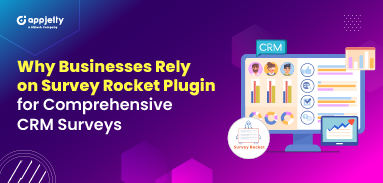Employees form a crucial part of an organization. As long as you don’t know what your employees think about your organization, policies, and regulations, you can’t gauge the level of satisfaction among them or even understand what motivates them.
You can say – a well-crafted employee engagement and satisfaction survey is the key to getting insights into the employees’ viewpoints fast and easy.
Now the question is – How to Create Perfect Employee Surveys?
Well, before we go on to discuss the answer in detail, let’s walk you through the types and benefits of employee surveys and how they can help ‘keep’ employees.
Here is how employee surveys can help an organization.
Benefits of Employee Surveys
✔️ Make Employees Feel Empowered
Employee surveys help build and nurture a conducive work environment where employees feel that they have the means to express their views, grievances, and concerns. It assures them that their voices are heard and they feel empowered.
Facilitates Communication between Different Hierarchical Levels
The leader of an organization is as good as the employees. If a leader needs to lead well, they must listen – to what the team has to say. And conducting employee opinion surveys can be one of the best and most efficient ways for that.
While it may not be practically possible to listen to every single employee’s issues or opinions, employee opinion surveys can streamline the conveying of ‘opinions’ to higher management.
✔️ Help Predict the Employees’ Behavior
To run your organization better, predicting your employees’ behavior and future actions can be highly helpful. By including some employee engagement surveys in your work culture, you can easily find out the general behavior of your employees and predict their level of commitment and dedication for your organization in the future.
Employee engagement surveys are more beneficial for an HR manager as they get valuable insights into employees’ engagement levels and can make efforts to retain the employees for long by forming new HR policies or modifying the existing ones accordingly, motivating the employees and increase their level of satisfaction and connect with the organization.
✔️ Help Identify Lesser-Known/Unreported Issues
Managing a workforce is a herculean task. A lot of issues go unspoken or unreported at times – especially in a big organization. If kept unreported, unnoticed, and unresolved for longer periods, they hamper the employees’ productivity and performance. Employee surveys can help identify these unreported issues and then you can take necessary actions in time to resolve them effectively before they aggravate and cause further harm to the organization.
✔️ Help Set Benchmarks for Employees’ Satisfaction
By repeating the same types of questions over a few surveys, you can easily gauge whether the employees’ satisfaction levels are increasing or decreasing over time by noting down employees’ responses every time and comparing them with the previous surveys’ results. This way, you can track the progress of your policies, HR team’s performance, and more.
Further, you can also set benchmarks for employee satisfaction and work accordingly to achieve them in stipulated time.
Types of Employee Surveys
The term ‘employee surveys’ is an umbrella term that includes various types of surveys:
➤ Employee Satisfaction Surveys – To help assess the overall satisfaction level of employees working at a point in time in the organization and find out the areas of dissatisfaction (if any) to improve them.
➤ Employee Engagement Surveys – To help identify the ground-level causes of employee satisfaction and strengthen those areas further to increase the overall productivity, job satisfaction, and loyalty.
➤ Employee Opinion Surveys – To help boost the employees’ morale by allowing them to express their views confidently.
➤ Organizational Assessment Surveys – To gain valuable insights into key forces responsible for the organization’s financial performance.
➤ 360-Degree Feedback Surveys – To help gather feedback from an employee’s immediate workgroup, including subordinates, peers, managers, or supervisors, and provide an evaluation.
➤ Onboarding Surveys – To help gather feedback from the new employees on how they found the organization and working environment and connect with them better.
➤ Exit Surveys – To help gather feedback from the employees who exit the company to evaluate the general perception of former employees about the organization.
Therefore, before you start creating an employee survey, decide on the type of survey you are going to take and prepare questions accordingly. Though questions in one type of survey can differ from another, there are still some general tips that you can follow to keep your employee surveys engaging, relevant, useful, and productive.
For instance, employee engagement survey questions can be more focused on determining how engaged an employee is with the organization and whether they would stay for long or not.
On the other hand, employee satisfaction survey questions can be focused more on determining whether an employee is currently satisfied or not and assess the level of satisfaction and to know whether they would continue for long or not.
General Tips on Utilizing Employee Surveys Effectively
➊ Keep Surveys Short and Relevant
As your employees have to answer the survey questions during their working hours, making surveys too long to fill can bore or distract them. As a result, survey completion can go down. Therefore, always keep the length short and employee engagement surveys questions easily comprehensible by avoiding any jargon.
Also, ensure to keep the sequence of the questions logical so that one question connects/transitions smoothly to the question following it and doesn’t seem like randomly placed, disconnected, or out-of-the-context.
For that, methods like –
Skip Logic – To help keep questions relevant in a survey as per responses to the previous questions beginning from the very first question.
Data Piping – To auto-fill some survey fields of employee surveys like the employee’s name and designation, etc. to save employees’ time.
can help.
➋ Maintain Anonymity
If you really want your employee surveys to garner ‘real’ and valuable feedback; assuring your employees of confidentiality and anonymity is a must. Assure them that their feedback would remain secured, strictly confidential only within the reach of the concerned personnel, and won’t be disclosed or leaked in public.
Assuring this anonymity would have a positive psychological impact on the employees’ mind and they would be able to submit their responses more honestly. Consequently, the data you get will give you the real picture of employees’ viewpoints and not just ‘moderated’ responses.
➌ Use Open-Ended Questions
Not all response options to all questions can cover all that one has to say.
Too philosophical!? Ok, let’s break it down to help you understand better in a layman’s terms.
While there are a majority of questions where 2, 3, or 4 response options can suffice, there are some that are different! And you can’t simply limit the responses – or more suitably, the answers to just a few options.
So, what to do?
Let your employees ‘write’ their answers rather than just ‘pick’ from the predefined responses. This implies that you should always include a minimum number of open-ended questions in your employee engagement surveys or employee opinion surveys to give your employees that extra ‘space’ to express what they want freely.
➍ Offer Incentives for Participation
While it may not always be practically or economically feasible to offer incentives, you can do this once in a while to keep encouraging employees to participate in surveys. These incentives can be anything – like a small treat at the cafeteria, or a one-hour early leave in the upcoming week, or any other small incentive like that based on the organization’s feasibility.
➎ Evaluate the Survey Results Efficiently
Until and unless you can’t evaluate your survey results efficiently, you can’t form strategies to improve your employees’ satisfaction or engagement levels. Only with proper and detailed analysis of the responses; you can draw some general conclusions and proceed to formulate some plans accordingly.
There are a number of online survey tools available that can help you with evaluating your survey results better through features like advanced statistical reports.
➏ Share the Survey Results
Positive or negative, the results of employee surveys must be made available to employees. Share the result of every survey via the medium you like – individually via email or publicly via an announcement. Sharing results will assure them that you heard them and care for them.
➐ Discuss the Action Plan
Employee surveys are not just to collect employees’ responses but also to evaluate them and implement the best possible strategies to improve their experience and engagement. So, make sure to announce the action plan you have decided to implement and welcome suggestions from employees if any.
Promise them that you will bring the changes the employees anticipate!
Ready to Create Employee Surveys?
An employee survey is an indispensable survey for an organization – whether big or small. So, it must be on-point and engaging enough to help collect honest feedback so as to form stronger relationships with employees.
If you too run an organization and are looking for a solution that can help you create engaging employee surveys, our SugarCRM survey module can be the right choice for you.
To know more about it or integrate it with your store, contact us at [email protected] and our team will revert to you within 24 hours.





